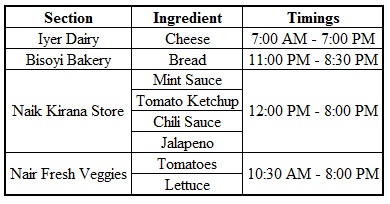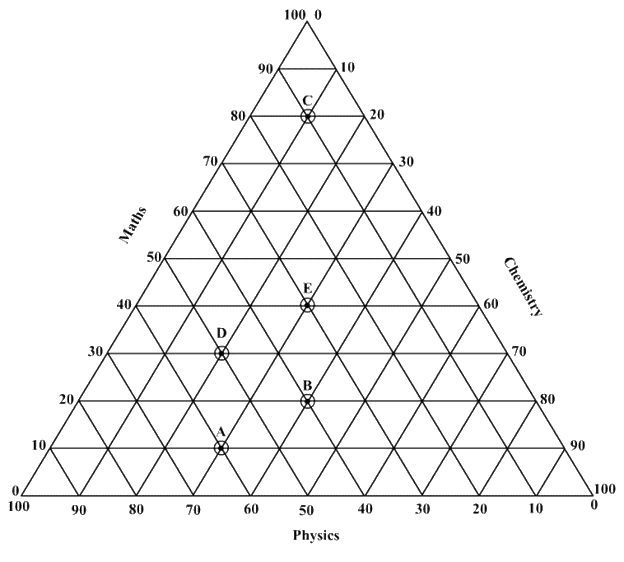- CAT Courses
- Free Video Resources & Tests
Video Resources
...
- Super 75
- CAT Past Papers
- Free Study Material
- BlogsDecember 23, 2025
XAT Time Management Tips 2026
December 21, 2025XAT Decision Making & GK Guide with PYQs for 2026 Prep
- Results
Condition-based sets are one of the most frequently tested and challenging types in the Data Interpretation & Logical Reasoning (DILR) section of CAT. These sets involve logic puzzles with constraints—often disguised in Seating Arrangements, Grouping, Matching, Scheduling, or Games & Tournaments formats.
Priya wants to have a sandwich for dinner. She decides to go to the mall from home and buy all the required ingredients. It takes her 15 minutes to travel from home to the mall and vice versa. The following table represents all the required ingredients and stores (within the mall) from which they can be bought:
Priya takes 15 minutes to select any ingredient. Once the items are selected, the time required to go from one store to another and to get the billing done is negligible. Priya reaches home at 8:30 PM, after buying all the ingredients and traveling back and forth in the minimum possible time. Also,

Correct Answer 1
D. NoneCorrect Answer 2
C. JalapeñosCorrect Answer 3
B. 1.25Correct Answer 4
16
There are seven students (A, B, C, D, E, F, G) who have decide to read one book out of B1 – B7 and one novel out of N1 – N7 on each day of the week from Monday to Sunday. Exactly one book and one novel is read every day. They read them in two slots- Morning and Evening – on each day. No friend reads the same book or novel twice and only one friend reads on a given day.
Correct Answer 1
c. 8
Correct Answer 2
b. B, Sat
Correct Answer 3
d. CBD
Correct Answer 4
a. 7
There are five parties – A, B, C, D and E – contesting in an election. There is a bet on the probable winner. As per the betting rules, if a person bets on a party and if
A person can bet on a maximum of three parties. In the election results, it is known that C came second
Q1. Ashok bets Rs.5,000 on A, Rs. 3,000 on B and Rs. 1,000 on D. In how many ways can A just recover his amount?
Correct Answer 1
0 ways
Correct Answer 2
1st Rank
Correct Answer 3
1080
Correct Answer 4
3
Q1. Who among the following manages the Equity fund?
Q2. Which of the following pairs has the maximum difference in the number of floors in between them?
Q3. The Sectoral Fund has its office on which floor of the building
Q4. What is the square of the sum of the floor numbers of offices of Kiran, Tina and Priyal?
Correct Answer 1
a. Tina
Correct Answer 2
c. Kiran - Chopra
Correct Answer 3
d. 3
Correct Answer 4
d. 100
Four friends A, B, C and D played a game of Poker. Initially, the number of chips that they had was in the 60s, 40s, 50s and 70s respectively, such that each one of them had a prime number of chips. They played 6 rounds of game such that the chips were only transferred among them. It is also known that:
Correct Answer 1
240
Correct Answer 2
3 Rounds
Correct Answer 3
Round 2
Correct Answer 4
Round 2
Q3. Sophie could visit which of the following locations?
Correct Answer 1
c. Rosie
Correct Answer 2
d. Princie
Correct Answer 3
c. Mussoorie
Correct Answer 4
d. No possible combination

Correct Answer 1
52
Correct Answer 2
66.66
Correct Answer 3
40%
Correct Answer 4
20
Correct Answer 1
47
Correct Answer 2
214
Correct Answer 3
c. 17
Correct Answer 4
a. 10
Correct Answer 1
d. 9
Correct Answer 2
a. U’s Car
Correct Answer 3
b. P’s car is in the third position
Correct Answer 4
d. 0 or 2

We at Quantifiers understand and deliver on the personal attention each of our students requires. Whether it is through our pedagogy that enables non-engineers or non-math background students, our constant effort to proactively provide solutions, or our focus on our student’s goals.